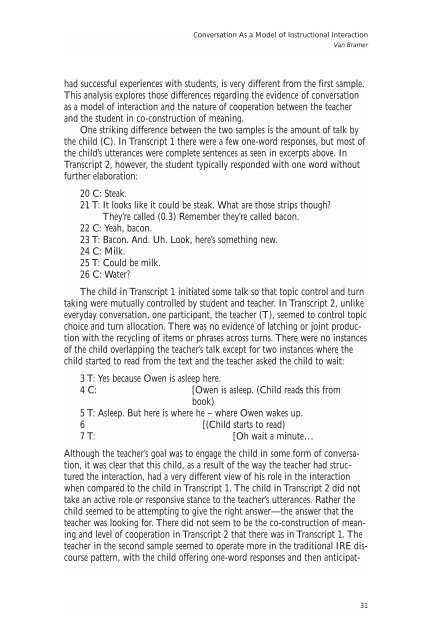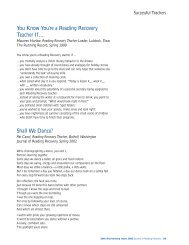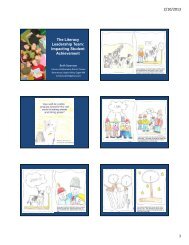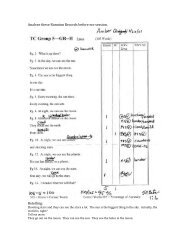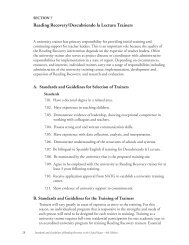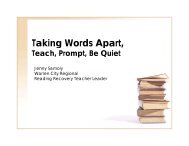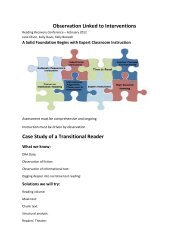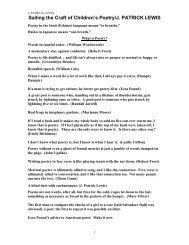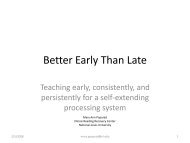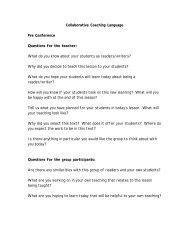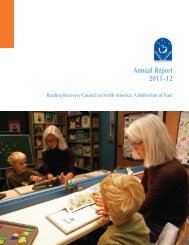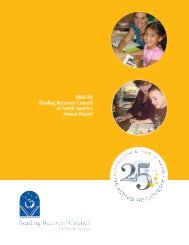Conversation As a Model of Instructional Interaction - Eric
Conversation As a Model of Instructional Interaction - Eric
Conversation As a Model of Instructional Interaction - Eric
You also want an ePaper? Increase the reach of your titles
YUMPU automatically turns print PDFs into web optimized ePapers that Google loves.
layout-8/l-2003 1/7/04 12:29 PM Page 31<strong>Conversation</strong> <strong>As</strong> a <strong>Model</strong> <strong>of</strong> <strong>Instructional</strong> <strong>Interaction</strong>Van Bramerhad successful experiences with students, is very different from the first sample.This analysis explores those differences regarding the evidence <strong>of</strong> conversationas a model <strong>of</strong> interaction and the nature <strong>of</strong> cooperation between the teacherand the student in co-construction <strong>of</strong> meaning.One striking difference between the two samples is the amount <strong>of</strong> talk bythe child (C). In Transcript 1 there were a few one-word responses, but most <strong>of</strong>the child’s utterances were complete sentences as seen in excerpts above. InTranscript 2, however, the student typically responded with one word withoutfurther elaboration:20 C: Steak.21 T: It looks like it could be steak. What are those strips though?They’re called (0.3) Remember they’re called bacon.22 C: Yeah, bacon.23 T: Bacon. And. Uh. Look, here’s something new.24 C: Milk.25 T: Could be milk.26 C: Water?The child in Transcript 1 initiated some talk so that topic control and turntaking were mutually controlled by student and teacher. In Transcript 2, unlikeeveryday conversation, one participant, the teacher (T), seemed to control topicchoice and turn allocation. There was no evidence <strong>of</strong> latching or joint productionwith the recycling <strong>of</strong> items or phrases across turns. There were no instances<strong>of</strong> the child overlapping the teacher’s talk except for two instances where thechild started to read from the text and the teacher asked the child to wait:3 T: Yes because Owen is asleep here.4 C: [Owen is asleep. (Child reads this frombook)5 T: <strong>As</strong>leep. But here is where he – where Owen wakes up.6 [(Child starts to read)7 T: [Oh wait a minute…Although the teacher’s goal was to engage the child in some form <strong>of</strong> conversation,it was clear that this child, as a result <strong>of</strong> the way the teacher had structuredthe interaction, had a very different view <strong>of</strong> his role in the interactionwhen compared to the child in Transcript 1. The child in Transcript 2 did nottake an active role or responsive stance to the teacher’s utterances. Rather thechild seemed to be attempting to give the right answer—the answer that theteacher was looking for. There did not seem to be the co-construction <strong>of</strong> meaningand level <strong>of</strong> cooperation in Transcript 2 that there was in Transcript 1. Theteacher in the second sample seemed to operate more in the traditional IRE discoursepattern, with the child <strong>of</strong>fering one-word responses and then anticipat-31


